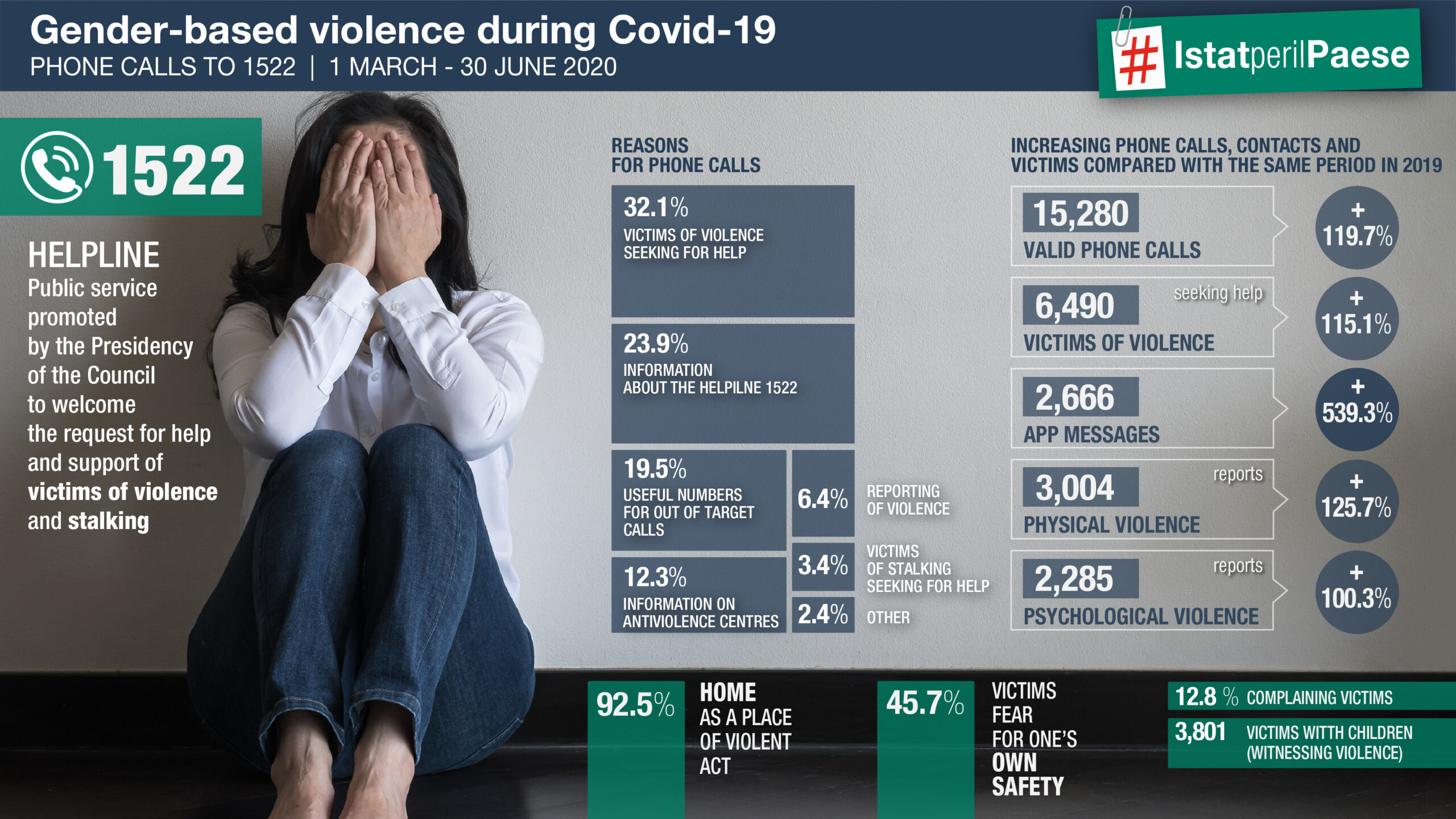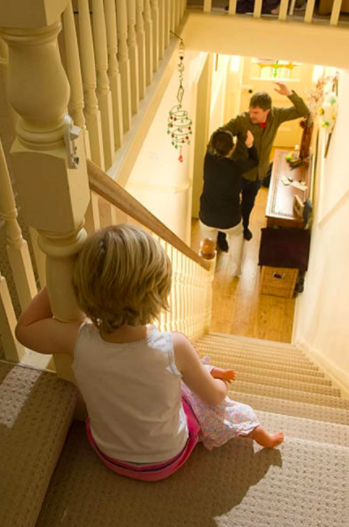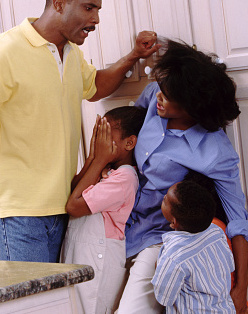My political commitment and professional activity have been devoted for over 30 years to defending the rights of women victims of male violence who are welcomed and housed in the centres against violenze of the Differenza Donna Association, and I can certainly state that our legal system, supplemented by international and European law sources which are directly applicable in our country on the basis of the obligation of interpreting them in accordance with Article 117 of the Constitution, is currently equipped with legal instruments that are suitable for repressing the phenomenon of gender-based violence against women.
The laws
 From a system that, until 1963, legitimised the ius corrigendi of the husband over his wife, we have come to build, thanks to the feminist movement, a system of legal instruments that consider male violence against women a violation of human rights. This was possible also thanks to the Istanbul Convention of the Council of Europe ratified by Italy in 2013, the United Nations CEDAW Convention on the Elimination of All Forms of Discrimination against Women ratified by Italy since 1985, and the ECHR Court.
From a system that, until 1963, legitimised the ius corrigendi of the husband over his wife, we have come to build, thanks to the feminist movement, a system of legal instruments that consider male violence against women a violation of human rights. This was possible also thanks to the Istanbul Convention of the Council of Europe ratified by Italy in 2013, the United Nations CEDAW Convention on the Elimination of All Forms of Discrimination against Women ratified by Italy since 1985, and the ECHR Court.
male violence against women recognised as a manifestation of the historically unequal power relation between the sexes
 This is also the case at a procedural level: from a system that transformed the victim into a defendant, we have moved on to recognising the victim as deserving of attention and protection (2012 European Union Directive on the rights of the victim) and lastly Law no. 69/ 2019 (the so-called Code of Red Law), in implementation of international laws, which has made further amendments to the Criminal Code and the Code of Criminal Procedure, to guarantee the protection of the rights and freedoms of women who report male violence. Today, we are therefore operating within a national legal framework of substantive and procedural law that is abstractly suitable to combat the phenomenon.
This is also the case at a procedural level: from a system that transformed the victim into a defendant, we have moved on to recognising the victim as deserving of attention and protection (2012 European Union Directive on the rights of the victim) and lastly Law no. 69/ 2019 (the so-called Code of Red Law), in implementation of international laws, which has made further amendments to the Criminal Code and the Code of Criminal Procedure, to guarantee the protection of the rights and freedoms of women who report male violence. Today, we are therefore operating within a national legal framework of substantive and procedural law that is abstractly suitable to combat the phenomenon.

The judiciary and the police have no more alibis. The serious problem, however, is the non-implementation of the rules: as the Strasbourg Court reminded us in October 2020 in its considerations on the initiatives taken after the final ruling of Talpis v. Italy. Consider also that the European Court of Human Rights, as well as the Grevio (Istanbul Convention Monitoring Body), in their report published on 13 January 2020 on the implementation of the Istanbul Convention both denounce that
male violence against women in italy is a phenomenon that is still submerged, unrecognised, often underestimated and with an inadequate judicial response
Obstacles when accessing to justice
 Women’s access to justice is hindered by the dissemination of sexist stereotypes and prejudices that compromise the establishment of facts in court. Firstly, women are not believed: sentences state that they are cunning, liars, manipulative, irrational, fickle, inconsistent, fragile, dependent on men, alienating, provocative. Stereotypes and sexist prejudices conceal the facts of violence and lead magistrates to adopt a behaviour that leads to discrimination against women, even to the impunity of the crime as it emerges from the results of the STEP 2020 research project conducted by the University of Tuscia in collaboration with the Differenza Donna Association, funded by the Department of Equal Opportunities of the Presidency of the Council of Ministers, which is based on the analysis of 228 criminal sentences between 2014 and 2020, concerning cases of ill-treatment, sexual violence, stalking.
Women’s access to justice is hindered by the dissemination of sexist stereotypes and prejudices that compromise the establishment of facts in court. Firstly, women are not believed: sentences state that they are cunning, liars, manipulative, irrational, fickle, inconsistent, fragile, dependent on men, alienating, provocative. Stereotypes and sexist prejudices conceal the facts of violence and lead magistrates to adopt a behaviour that leads to discrimination against women, even to the impunity of the crime as it emerges from the results of the STEP 2020 research project conducted by the University of Tuscia in collaboration with the Differenza Donna Association, funded by the Department of Equal Opportunities of the Presidency of the Council of Ministers, which is based on the analysis of 228 criminal sentences between 2014 and 2020, concerning cases of ill-treatment, sexual violence, stalking.
women are said to exaggerate, psychological ill-treatment and economic violence are minimised, even when they have very serious repercussions of dependency and subjection which are sometimes prodromal to feminicide
 The last punitive act is almost always planned, of a long series of psychological, sometimes physical, violence. Violence suffered by a partner or an ex-partner is systematically confused with conflict within a couple, undermining not only the rights and freedom of women but also the rights of children. We talk about “conflict situations” or “family quarrels”, making the man responsible for the violence on the same level as the woman who suffers it. Men’s violence is too often interpreted as a “reaction” to women’s behaviour, misrepresenting reality and even blaming the woman for not being able to contain the man’s outbursts.
The last punitive act is almost always planned, of a long series of psychological, sometimes physical, violence. Violence suffered by a partner or an ex-partner is systematically confused with conflict within a couple, undermining not only the rights and freedom of women but also the rights of children. We talk about “conflict situations” or “family quarrels”, making the man responsible for the violence on the same level as the woman who suffers it. Men’s violence is too often interpreted as a “reaction” to women’s behaviour, misrepresenting reality and even blaming the woman for not being able to contain the man’s outbursts.
It can also be assessed as a “situation of tension” between the married couple, determined by character reasons and not by the husband’s overpowering behaviour towards his wife.
Stereotypes and prejudices in rulings
 Applying a discounted sentence to the husband who kidnaps, beats and rapes his wife because she is considered too casual (Milan Court of Appeal of 18 September 2020), means concealing the responsibility of the perpetrator of the crimes, blaming the woman, justifying the violent man who turns from aggressor into a victim. It means putting the State’s stamp of approval on that sexist stereotype whereby a free and “nonchalant” woman can be abused and raped by her husband.
Applying a discounted sentence to the husband who kidnaps, beats and rapes his wife because she is considered too casual (Milan Court of Appeal of 18 September 2020), means concealing the responsibility of the perpetrator of the crimes, blaming the woman, justifying the violent man who turns from aggressor into a victim. It means putting the State’s stamp of approval on that sexist stereotype whereby a free and “nonchalant” woman can be abused and raped by her husband.
judicial stereotypes are used also by lawyers who convey in their defence the most outdated patterns of behaviour with questions. they are admitted by the judges or the judge, and aimed exclusively at confirming the prejudice that the woman is to blame for the crime
 The cultural substratum conveyed in the courtrooms by the defence of the accused is almost always filled with sexist suggestions: instead of using legal arguments, contesting the facts on the basis of evidence, the woman is accused of being an inadequate wife or mother before whom “the accused has lost his mind”. In crimes of sexual violence where the most remote sexist stereotypes and prejudices lurk: it is said that the woman provokes, that if she had wanted to she could have escaped the violence, or that if she agreed to drink, it means that she also was consensual to the sexual intercourse. Starting from the prejudice that the woman is mendacious, it is stated that there is no consent only when there is evidence of physical resistance to a sexual aggression. This happens also in situations that exclude the possibility of the woman giving valid consent or resistance, such as when the woman is paralysed by fear.
The cultural substratum conveyed in the courtrooms by the defence of the accused is almost always filled with sexist suggestions: instead of using legal arguments, contesting the facts on the basis of evidence, the woman is accused of being an inadequate wife or mother before whom “the accused has lost his mind”. In crimes of sexual violence where the most remote sexist stereotypes and prejudices lurk: it is said that the woman provokes, that if she had wanted to she could have escaped the violence, or that if she agreed to drink, it means that she also was consensual to the sexual intercourse. Starting from the prejudice that the woman is mendacious, it is stated that there is no consent only when there is evidence of physical resistance to a sexual aggression. This happens also in situations that exclude the possibility of the woman giving valid consent or resistance, such as when the woman is paralysed by fear.
Women do not scream, they are afraid to die
 This means denying the experience of hundreds of women we receive in centres against violence, who state that non-reaction to sexual violence is a form of self-protection: women do not scream, they do not react because they are afraid of being killed. For example it is the case of sexual violence committed by the abusive partner in a context of habitual abuse and exercise of power and control. Sexual violence where women do not resist or do not express explicit dissent because they are afraid of further violent reactions. This crime is widespread.
This means denying the experience of hundreds of women we receive in centres against violence, who state that non-reaction to sexual violence is a form of self-protection: women do not scream, they do not react because they are afraid of being killed. For example it is the case of sexual violence committed by the abusive partner in a context of habitual abuse and exercise of power and control. Sexual violence where women do not resist or do not express explicit dissent because they are afraid of further violent reactions. This crime is widespread.
The same happens on the basis of sexist stereotype that women are sexually available, they deny the crime even when they report vaginal injuries reported by the emergency room as a result of the reported sexual assault
Rulings in which the injuries are motivated as “expressions of a consensual passionate relationship particularly energetic and carried out with enthusiasm due to the state of strong excitement of the man”. The man acted “in an energetic and fiery way […] with particular exuberance on the level of sexual approaches”: going so far as to argue that “it cannot be excluded that he has carried out an energetic divarication without that actual prevarication of the will of the partner” (Court of Appeal of Cagliari 2017). This is a ruling that we have brought to the attention of the Cedaw Committee F/C Italy 2019 and is currently still in the decision-making phase.
The woman is not believed
 Again, the woman is diabolical, cunning: in the case in which I assisted an underage girl raped by a man of her age, the defendant’s strategy was to claim that the girl was lying to get revenge because no he had rejected her. This prejudice stems from the stereotype that a woman only exists if she is recognised by the gaze of a man. A widespread prejudice is also that of instrumental lawsuits brought in the course of the separation or of custody proceedings, despite the fact that the experience centres against violence show that women report during the separation phase in order to protect their own and their children’s safety because the abusive man does not accept the woman’s rebellion. In front of her free choice to end the relationship, the man punishes her by worsening his violent conduct, even going so far as to kill her.
Again, the woman is diabolical, cunning: in the case in which I assisted an underage girl raped by a man of her age, the defendant’s strategy was to claim that the girl was lying to get revenge because no he had rejected her. This prejudice stems from the stereotype that a woman only exists if she is recognised by the gaze of a man. A widespread prejudice is also that of instrumental lawsuits brought in the course of the separation or of custody proceedings, despite the fact that the experience centres against violence show that women report during the separation phase in order to protect their own and their children’s safety because the abusive man does not accept the woman’s rebellion. In front of her free choice to end the relationship, the man punishes her by worsening his violent conduct, even going so far as to kill her.
the abusive man continues to exert power and control even during parental visits to the children. But women are not believed
 In the civil rulings, in the acts of the social services and in the technical consultations ordered by the civil judges, the partner’s violence is denied and we read of conflictual relationships, of relational violence, but we do not recognise the situation of prevarication and control exercised by the man: this conduct is in no way compatible with the exercise of parental responsibility. In spite of the fact that the Istanbul Convention imposes to take into consideration the witnessing violence suffered by children “when determining the father’s rights to visit his children”, in reality the violent man is rarely invited to become aware of the seriousness of his conduct and of its reverberation on the life of his children.
In the civil rulings, in the acts of the social services and in the technical consultations ordered by the civil judges, the partner’s violence is denied and we read of conflictual relationships, of relational violence, but we do not recognise the situation of prevarication and control exercised by the man: this conduct is in no way compatible with the exercise of parental responsibility. In spite of the fact that the Istanbul Convention imposes to take into consideration the witnessing violence suffered by children “when determining the father’s rights to visit his children”, in reality the violent man is rarely invited to become aware of the seriousness of his conduct and of its reverberation on the life of his children.
children placed in shelter houses with their mothers are traumatised by having witnessed their father’s violence against their mother at home
Children and the stigmatisation of women in the TCO
 Yet, women are not believed even when they represent their children’s fears of meeting their father, so much so that they are stigmatised by the technical consultants as “overprotective”, “malicious”, “unfriendly”, “uncooperative” with the other parent, “hostile”, “paranoid’, “symbiotic”, or even “alienating”. On this point, I would like to point out that the technical consultants appointed by the civil judge during the separation or custody of minor children have only an auxiliary function to the judge, as provided for by the code, but in fact they are now the main source of the Civil Judicial Authority’s assessment and often express their opinion in contrast with the measures issued in criminal proceedings for the protection of women.
Yet, women are not believed even when they represent their children’s fears of meeting their father, so much so that they are stigmatised by the technical consultants as “overprotective”, “malicious”, “unfriendly”, “uncooperative” with the other parent, “hostile”, “paranoid’, “symbiotic”, or even “alienating”. On this point, I would like to point out that the technical consultants appointed by the civil judge during the separation or custody of minor children have only an auxiliary function to the judge, as provided for by the code, but in fact they are now the main source of the Civil Judicial Authority’s assessment and often express their opinion in contrast with the measures issued in criminal proceedings for the protection of women.
Today, the Senate Commission of Inquiry refgarding feminicide, chaired by the Honourable Valeria Valente, is analysing these problems reported by the lawyers of the centres against violence
 In the centres against violence, we assist women who despite having obtained a specific precautionary measure from the criminal judge to protect their integrity, such as the order to leave the family or the prohibition to approach the places usually attended by her, are then obliged during the technical consultancy, to meet the man to carry out the same proceeding. Too often the court-appointed technical consultants put the parents on the same level and invite them to undertake mediation, in contrast with the principles of the Istanbul Convention and the EU Directive No. 29 /2012, which invites the State authorities to reduce the contact between the offender and the victim, giving precedence to the objective of rehabilitating the father figure and underestimating the danger also for the children.
In the centres against violence, we assist women who despite having obtained a specific precautionary measure from the criminal judge to protect their integrity, such as the order to leave the family or the prohibition to approach the places usually attended by her, are then obliged during the technical consultancy, to meet the man to carry out the same proceeding. Too often the court-appointed technical consultants put the parents on the same level and invite them to undertake mediation, in contrast with the principles of the Istanbul Convention and the EU Directive No. 29 /2012, which invites the State authorities to reduce the contact between the offender and the victim, giving precedence to the objective of rehabilitating the father figure and underestimating the danger also for the children.
underestimation that exposes women to secondary victimisation throughout the civil and criminal justice process: prohibited by the istanbul convention
 The obligation to eradicate and prevent sexist stereotypes among legal professionals is enshrined in the 2015 General Recommendation N. 33 on women’s access to justice, Article 5 of the CEDAW, Article 12 of the Istanbul Convention. Eliminating gender stereotypes and prejudices in the justice system is a crucial step to guarantee the right to non-discrimination and equality between men and women, the right to a fair trial, equality before the law (art. 2,3,111 Const). The issue of male violence against women is a social and political issue with historical and cultural roots, and therefore modifiable only thanks to the collective commitment of all for a social reform that will benefit the community, helping to rewrite the grammar of the dynamics of the process, but also and mainly the relations between the two sexes.
The obligation to eradicate and prevent sexist stereotypes among legal professionals is enshrined in the 2015 General Recommendation N. 33 on women’s access to justice, Article 5 of the CEDAW, Article 12 of the Istanbul Convention. Eliminating gender stereotypes and prejudices in the justice system is a crucial step to guarantee the right to non-discrimination and equality between men and women, the right to a fair trial, equality before the law (art. 2,3,111 Const). The issue of male violence against women is a social and political issue with historical and cultural roots, and therefore modifiable only thanks to the collective commitment of all for a social reform that will benefit the community, helping to rewrite the grammar of the dynamics of the process, but also and mainly the relations between the two sexes.




 This is the english section of
This is the english section of 